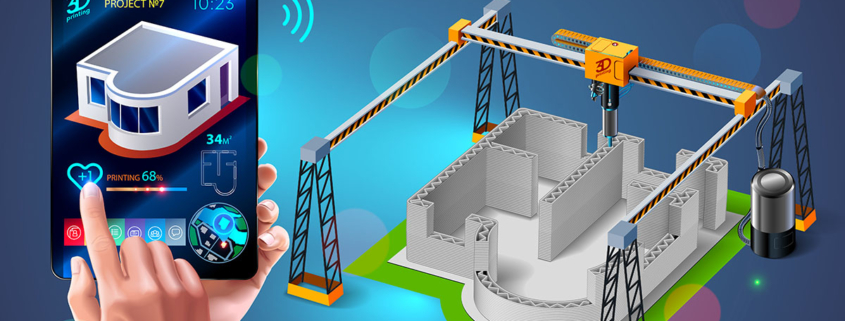Can 3D Construction Printing Save Time and Money?
Three-dimensional construction printing (3DCP) is becoming a more popular application in the construction industry to create three-dimensional structures on site or to manufacture components off site for later assembly.
Before 3DCP was introduced in the mid-1990s, 3D printing was first used in Japan in 1981, and initially used in the U.S. by a furniture builder to create small custom parts. The first large-scale construction 3D printer was built in the mid-2000s.
About 3D Construction Printing
In 3DCP, a software program sends dimensions to a 3D printer, which builds the structure on a platform using plastic, cement, or liquid metals.
3DCP can be used to complete end-to-end construction jobs, including buildings and bridges, as well as to create parts, prototypes, and architectural models. It’s usually more cost effective and environmentally friendly than traditional construction methods. For example, a 3D-printed building prototype could give an owner a good idea of what the finished building will look like before breaking ground.
Similarly, 3D-printed architectural models allow architects and owners to inspect the design and layout of a structure before construction begins. Such models have traditionally been built manually, but with 3DCP they can be built faster and cheaper. 3DCP can also be used to create parts more cost effectively.
There are two main types of 3D construction printing.
In contour crafting, a robotic arm extruder moves back and forth releasing materials that create layers. Rails are installed around building spaces to allow the arm to change height and position as needed. This method is typically used for smaller 3DCP projects.
In sand printing, layers of sand are released by the 3D printer to build structures and components. The printer releases droplets that harden and bind the sand once the desired level of thickness is reached.
3DCP can also be combined with other construction technology like welding. For example, a robotic arm can layer raw metals that can then be welded together as they’re printed.
Potential Benefits of 3DCP
3D printing has the potential to reshape the construction industry as we know it. The 3DCP market is growing fast and expected to reach $1.5 billion by 2024.
3DCP offers several potential benefits to contractors and the construction industry:
Design flexibility. Architects can create complex designs that might not be practical or affordable if built using traditional construction methods. This allows more innovation and creativity when designing structures. Components can be created in any shape and size needed and are a one-to-one copy of what has been designed on paper.
Time savings. Depending on the structure, 3D construction printing can reduce the time required to build it from weeks or months to days. Construction work can proceed 24/7 in all kinds of weather conditions with minimal human supervision. According to one estimate, 3DCP reduces time by 60 percent compared to traditional construction methods.
Cost savings. Because 3DCP is an additive manufacturing process, it uses only as much material as is needed to build a structure or part, which saves money and reduces waste. Less human involvement is also required, which lowers labor costs. According to one estimate, 3DCP can save up to 80 percent on labor compared to traditional construction methods.
Increased worker safety. Construction accounts for a large percentage of workers killed on the job each year, according to OSHA. The automation provided by 3DCP can reduce the number of accidents, injuries, and deaths that occur on job sites.
Construction consistency. The building blocks of 3DCP remain the same regardless of where a project is located. Robotic arms, software, and cement are the same in California as they are in Connecticut or Canada, which helps ensure consistency from one project to another.
Challenges of Adopting 3DCP
Despite these benefits, there are challenges to the widespread adoption of 3D printing in the construction industry. For starters, 3DCP requires a large upfront investment to purchase the equipment and software, as well as the ongoing costs of materials and maintenance. There may also be logistical challenges and costs in getting the equipment to jobsites—where it’s needed.
It can also be difficult and costly to hire the highly skilled workers needed to operate 3DCM equipment and technology. Without these employees, quality control may suffer.
The current lack of government guidelines and regulations around 3DCM is another drawback. Contractors could face liability when using computers and printers instead of humans to perform some construction tasks. Some contractors might be hesitant to try 3DCM until these legal and regulatory issues are clarified.
Worth Considering
Your construction project might benefit from the savings and efficiency of 3D construction printing. This new technology is worth exploring with your project team.
